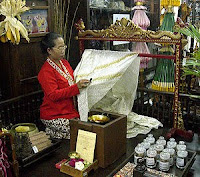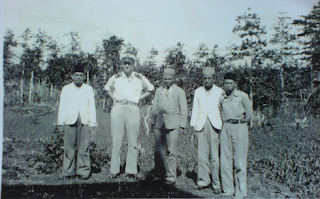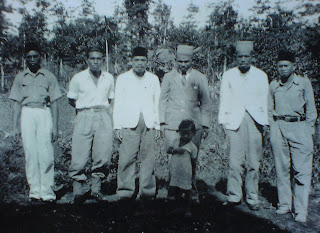The first photograph of Borobudur in 1873. Appeared on the Dutch flag the main stupa of the temple.
One of the carvings on the walls Karmawibhangga Borobudur temple (the southeast corner of the floor 0)
Restoration of the monument Borobudur temple with the help of UNESCO
Borobudur is the name of a Buddhist temple located at Borobudur, Magelang, Central Java. Location of the temple is approximately 100 km in the south-west of Semarang and 40 km northwest of Yogyakarta. This temple was founded by the Mahayana Buddhists around the year 800 AD the dynasty during the reign of Sailendra.
The name of Borobudur
Many theories attempt to explain the name of this temple. One of them states that the name is probably derived from the word Sambharabhudhara, which means "mountain" (bhudara) where the slopes are located terraces. In addition there are some other popular etymology. Suppose borobudur word comes from the word "the Buddha" is due to shift into borobudur sound. Another explanation is that the name comes from two words "coal" and "beduhur". Said coal said to have originated from the monastery, while there is also another explanation in which the coal comes from Sanskrit which means temple or monastery complex and beduhur meaning is "high", or to remind the Balinese language means "above". So the intention is a monastery or hostel located in the high ground.
Historians J.G. de Casparis in his dissertation to obtain his doctorate in 1950 argued that Borobudur is a place of worship. Based on the inscriptions and Kahulunan Karangtengah, Casparis estimates, founder of the Borobudur is the king of the dynasty named Samaratungga Syailendra around 824 AD The giant new buildings can be completed at the time of her daughter, Queen Pramudawardhani. Development of Borobudur estimated half-century time-consuming.
Borobudur Structure
Borobudur berundak punden shape, which consists of six levels of a square, three-level circular and a circular main stupa as a peak. Also scattered in all levels-the levels several stupas.
Borobudur is a ten-story clearly illustrates the Mahayana school of philosophy. like a book, Borobudur describes ten Bodhisattva levels which must pass to reach the perfection of the Buddha.
The foot of Borobudur represents Kamadhatu, the world is still dominated by kama, or "low desire". This section is mostly covered by a pile of stone that allegedly made to strengthen the construction of the temple. In the closed structures have an additional 120 panels Kammawibhangga story. A small portion was set aside additional structure so that people can still see the relief in this section.
Four floors with walls above berelief by the experts called Rupadhatu. The floor is rectangular. Rupadhatu the world who have set themselves free from lust, but is still bound by the appearance and shape. This level represents the nature of that is, between nature and the natural bottom up. In part this Rupadhatu Buddha statues found on the wall niches above ballustrade or hallway.
Start fifth to the seventh floor of the walls not berelief. This level is called Arupadhatu (which means no tangible form or not). Circular floor plan. This level represents the nature of, where people are free from all desires and the bond forms and shapes, but have not reached nirvana. Buddha statues are placed in the stupa covered with holes as in a cage. From outside the statues were still dim.
Which describes the highest level being represented by the absence of a stupa, the largest and highest. Stupa described plain without the holes. Within this the largest stupa, believed there was a statue Adibuddha representations. The statue is thought to have come from the largest stupa is now placed in an archeological museum, a few hundred meters from the Borobudur temple. This statue is known as the Buddha unfinished.
In the past, several statues of Buddha along with the 30 stone reliefs, two lions, a few times-shaped stone, stairs and gates are sent to the King of Thailand, Chulalongkorn, who visited the Dutch East Indies (now Indonesia) in 1896 as a gift from the Dutch Government as that.
Borobudur has no worship spaces like the other temples. That there are long passages that are narrow streets. The hallways surrounding the walled temple level by level. In these corridors is expected Buddhist ritual walk around the temple to the right. The shape of the building without room and terraced structure is alleged is the development of berundak punden form, which is a form of original architecture from prehistoric Indonesia.
Borobudur structure when viewed from above form a mandala structure.
Borobudur structure does not use cement at all, but the Interlock system is like Lego blocks that can be attached without glue.
Relief
At every level carved reliefs on temple walls. These reliefs read as counter-clockwise or called mapradaksina in Old Javanese language derived from Sanskrit meaning is daksina east. These reliefs variety of story content, among other reliefs there about the epic Ramayana. There are also reliefs Jataka stories.
Reading of the stories are always the starting relief, and ends on the east side of the gate on each level, starting on the left and ends on the right of the gate. So obviously that the east is the ladder up the real (main) and to the top of the temple, it means that the temple facing the east while the other sides of similar right.
The composition and distribution of relief story ledge on the wall and the temple, are as follows:
Relief Chart
Level position / location Relief Story Number Frames
----- Original foot temple Karmawibhangga 160 frames
Level I - walls a. 120 frames Latitawistara
------- - ----- B. Jataka / awadana 120 frames
------- - Ledge a. Jataka / awadana 372 frames
------- - ----- B. Jataka / awadana 128 frames
Level II - wall frame Gandawyuha 128
-------- - Ledge Jataka / awadana 100 frames
Level III - 88 frames Gandawyuha wall
-------- - 88 frames Gandawyuha ledge
Level IV - 84 frames Gandawyuha wall
-------- - 72 frames Gandawyuha ledge
1460 -------- -------- Number of frames
In sequence, the story of the temple reliefs in ringkat significantly as follows:
Karmawibhangga
One of the carvings on the walls Karmawibhangga Borobudur temple (the southeast corner of the floor 0) In accordance with the symbolic meaning of the foot of the temple, reliefs that decorated the walls of these hidden shelf, described the law of karma. Rows of relief is not a story series (series), but in each frame describes a story that has a causal correlation. Relief is not only give you an idea of human moral turpitude accompanied by penalties that will get, but also the human good deeds and reward. As a whole is a depiction of human life in the circle of birth - life - death (samsara) that never ends, and by the Buddhist tersebutlah chain which will be ended to to perfection.
Lalitawistara
History is a depiction of the Buddha in a row of relief (but not a complete history) which starts from the Buddha's descent from heaven Tusita, and ends with the first sermon in the Deer Park near the city of Banaras. These reliefs lined the stairs on the south side, after a row exceeded the relief of 27 frames starting from the east side of the stairs. 27 frame to describe the activity, both in heaven and on earth, in preparation to welcome the presence of the last incarnation as the candidate of the Bodhisattvas are Buddhist. Reliefs depicts the birth of the Buddha in this arcapada as Prince Siddhartha, son of the King and Queen Maya Suddhodana of State Kapilavastu. Relief amount to 120 frames, which ended with the first discourse, which is symbolically expressed as play Wheel of Dharma, the Buddha's teaching is called dharma also means "law", while represented as a wheel of dharma.
Jataka and Awadana
Jataka tales are stories of the Buddha before he was born as Prince Siddharta. Protrusion of the contents is the subject of good works, which distinguishes the Bodhisattvas from any other creature. Indeed, the collection service / good deed is the preparation stage in an attempt to keringkat the buddha's.
Awadana while basically similar to the Jataka but the culprit is not the Bodhisattvas, but other people and the stories collected in the book which means Diwyawadana sainthood noble deeds, and the book of a hundred stories Awadanasataka or Awadana. In the reliefs of Borobudur temple and awadana Jataka, treated the same, meaning they are in the same row without a distinguishable. The set of the most famous of the life of the Bodhisattvas is Jatakamala or strands Jataka stories, Aryasura and poet who lived in the 4th century AD.
Gandawyuha
Is a row of reliefs decorate the walls of the hall to the 2, is the story of a wandering Sudhana tirelessly in his quest for knowledge about the Supreme Truth by Sudhana True. Description of the frame 460 based on Mahayana Buddhist scripture entitled Gandawyuha, and for the lid on the story of another Bhadracari.
Stages of development of Borobudur
The first stage
Construction period is not known certainly Borobudur (estimated between 750 and 850 AD). Initially built-storey apartment layout. It seems designed as a pyramid berundak. but later changed. As evidence of stacking order dismantled.
The second stage
Borobudur foundation widened, plus two square steps and one step directly circle given a large parent stupas.
Third stage
Steps up the circle with a large main stupa dismantled and removed and replaced by three railroad circles. Stupas built on top of these steps with a large stupa in the middle.
Stage four
There are small changes like making relief changes and curved stairs above the door.
Overview of time the process of restoration of Borobudur Temple
The first photograph of Borobudur in 1873. Flag of the Netherlands looked at the main stupa candi.1814 - Sir Thomas Stamford Raffles, Governor-General of the United Kingdom in Java, heard of the discovery of archaeological objects in the village of Borobudur. Raffles ordered H.C. Cornelius to investigate the discovery site, a hill covered with shrubs.
1873 - The first monograph published about the temple.
1900 - Dutch East Indies government established a committee of the restoration and maintenance of Borobudur temple.
1907 - Theodoor van Erp led the restoration until 1911.
1926 - Borobudur restored again, but stopped in 1940 due to malaise and the crisis of World War II.
1956 - Indonesian government requested the assistance of UNESCO. Prof. Dr. C. Coremans came to Indonesia from Belgium to investigate the causes of damage to Borobudur.
1963 - Indonesian government issued a decree to restore Borobudur, but the mess after the event G-30-S.
1968 - at the conference-15 in France, UNESCO agreed to provide assistance to rescue Borobudur.
1971 - Indonesian government established a body chaired by the restoration of Borobudur Prof.Ir.Roosseno.
Restoration of the monument Borobudur temple with the help of UNESCO1972 - International Consultative Committee was formed with the involvement of various countries and Roosseno as chairman. UNESCO-sponsored committees provide 5 million U.S. dollars from the cost of 7750 million dollar restoration of the United States. The rest covered Indonesia.
August 10, 1973 - President Soeharto inaugurated the start of the restoration of Borobudur; restoration was completed in 1984
January 21, 1985 - bomb attacks that destroyed some of the stupa at Borobudur Temple, it was soon restored. The attack carried out by an extreme Islamic group led by Habib Husein Ali Alhabsyi.
1991 - Borobudur designated as a UNESCO World Heritage.
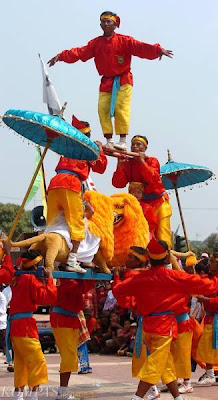 In his art sisingaan there are elements such as art and dance, sports (Pencak Silat and Jaipongan), karawitan art, literature and art and clothing. All these elements together form a cohesive and a dance and song and added the movement that formed a stuntman formation as standen.
In his art sisingaan there are elements such as art and dance, sports (Pencak Silat and Jaipongan), karawitan art, literature and art and clothing. All these elements together form a cohesive and a dance and song and added the movement that formed a stuntman formation as standen.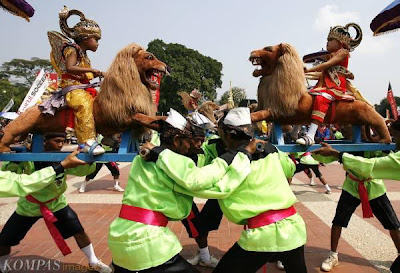 Music suite.
Music suite.





